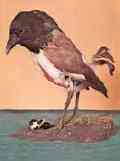
The Bare-fronted Hoodwink
|
Add Comment |
|
Back to Creature Gallery |
The Bare-fronted Hoodwink
(Dissimulatrix spuria)
Ornithologist M.F. Meiklejohn first described the Bare-fronted Hoodwink (scientific name Dissimulatrix spuria) in a 1950 article in the scientific journal Bird Notes. Meiklejohn surmised the existence of the Hoodwink after a long and careful study of birds "partially seen or indeterminately heard." He determined that all such partial sightings could be attributed to a single species: the Hoodwink.
According to Meiklejohn, the Hoodwink exhibits a talent for being almost seen or almost captured. He advised that bird watchers in the field could recognize the species by its "blurred appearance and extremely rapid flight away from the observer." Amateur bird watchers appeared to have more luck spying it than did more experienced observers.
The photo to the left represents the only known example of the Hoodwink in a scientific collection. It was put on display in the Royal Scottish Museum at Edinburgh on April 1, 1975. Visitors to the exhibit remarked that it looked oddly like a stitched-together patchwork of random parts from various different species. For instance, the head resembled that of a Carrion Crow, the body bore a striking similarity to a plover, and the feet were like those of a wading bird. The Hoodwink's bare front resembled wax.
Accompanying the exhibit were photographs of the Hoodwink taken in the field. Unfortunately, in all frames the Hoodwink had been "just missed."
References:
- Peter Dance. Animal Fakes & Frauds. Sampson Low (1976): 80.
- M.F. Meiklejohn. "Notes on the Hoodwink (Dissimulatrix spuria)." Bird Notes 24 (1950): 89-92.